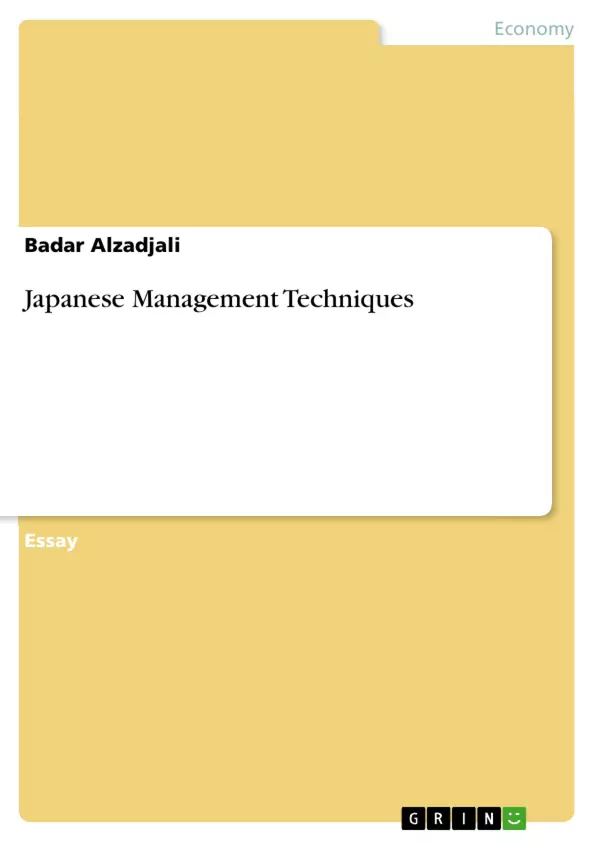Japanese Management Techniques
Alzadjali, B. (2009)
2 - 10
There is no doubt that every person from all walks of life is indeed using a
Japanese product or technology in his daily life, whether it is cars, pens or paper. Indeed,
Japan provided the world with many successful global companies and brands such as
Sony, Fujitsu, HP and Toyota. These global Japanese brands did not only affect Japanese
economy, it also affected the world economy and trade. These industrial revolutions put
Japan on one of the six big industrial countries alongside the United States, United
Kingdom, Germany, France and Italy. It is not the manufacturing elements that made
Japan reach that, but there is also a great management system. The success of their
approaches was not by adopting a fixed accounting system or by Activity-based costing
ABC, but by using systematic flexible systems (Patel and Russell 1994, pp.64-65).
In the last 50 years, Japan brought to the world a successful management style starting
with a government model in the early 1950s, to a corporate model in the 1980s (Porter et
al. 2002; Whitehill 1991). The root of the modern Japanese management goes back to
post Second World War, when Japan started its economic recovery. Japan started a
phenomenal revolution management system (Porter et al. 2002; Whitehill 1991). Towards
the 1970s, research showed that the United States and some European countries used a
similar system (Hayashi 2002). In 1980s the time came to challenge just how these
systems would work out under the Japanese corporate management systems.
Professor William Ouchi's book, about the Japanese management system entitled Theory
Z: how American business can meet the Japanese challenge (England 1983; Hayashi
2002). The book became a standard management system practice in the United States for
more than 20 years. During the last century, there were many theories which appeared on
the table based on Japanese model from theory X to Z. However, the American
companies did not found any productivity value on this model system and the theory Z
management application became unlikely used among American companies and
businessmen (England 1983; Whitehill 1991; Jeremiah J, 1992) perhaps because of
differences in the environment or the culture. However, the Japanese culture has played
an important role in the Japanese management system. In fact, the Japanese firm
management system was based on two functions; columns economy and culture.
Inhaltsverzeichnis (Table of Contents)
- Introduction
- Japanese Management Techniques
- The Japanese Cultural Characteristics
- Toyota's Production System
- Just-In-Time Approach
- JIT: A Philosophy
- JIT: A System
- Advantages and Disadvantages
- Lean Thinking Approach
- Lean Thinking: A Philosophy
Zielsetzung und Themenschwerpunkte (Objectives and Key Themes)
This essay explores the concept of Japanese management techniques, focusing on the Just-In-Time (JIT) approach and Lean Thinking. It aims to highlight the application of these techniques within the manufacturing industry, investigating their advantages and disadvantages.
- Japanese management systems and their cultural context
- The Toyota Production System (TPS) and its core values
- The Just-In-Time (JIT) approach: philosophy, implementation, and impact
- Lean Thinking: a philosophy for achieving efficiency and value creation
- Advantages and challenges associated with JIT and Lean Thinking
Zusammenfassung der Kapitel (Chapter Summaries)
The essay begins by introducing the concept of Japanese management techniques and their historical development. It then delves into the Toyota Production System (TPS), a key example of Japanese management practices. The TPS, built upon the idea of waste reduction and efficiency, is introduced as the foundation for the Just-In-Time (JIT) approach.
The Just-In-Time (JIT) approach is explored in detail, focusing on its philosophy of minimizing waste and maximizing efficiency in production. The chapter explores the implementation of JIT, its benefits, and potential pitfalls. Examples from companies like Toyota, Dow Chemical, and Xerox are used to illustrate the practical application of JIT.
The essay concludes by introducing Lean Thinking, another Japanese management philosophy focused on identifying and eliminating waste in all aspects of production. The chapter briefly discusses the core principles of Lean Thinking and its potential benefits.
Schlüsselwörter (Keywords)
The main keywords and focus topics of this essay include Japanese management techniques, Toyota Production System (TPS), Just-In-Time (JIT), Lean Thinking, waste reduction, efficiency, manufacturing, supply chain management, and cultural influence.
- Quote paper
- Badar Alzadjali (Author), 2009, Japanese Management Techniques , Munich, GRIN Verlag, https://www.grin.com/document/156452



